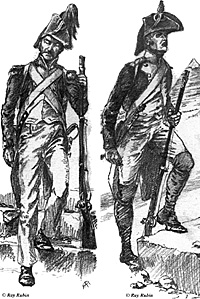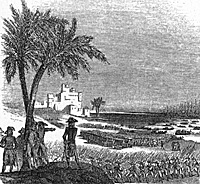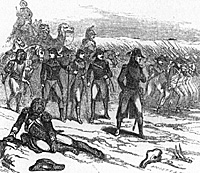 The Expedition Arrives
The Expedition Arrives
Napoleon's fleet arrived off the coast of Egypt at the end of the June. Informed that the English had arrived just two days before, Napoleon began disembarking as quickly as possible.
30 of the 41 infantry battalions with the Army of the Orient were line infantry. Each line demi-brigade had three battalions, with each battalion consisting of one elite company of grenadiers (figure on left), and eight companies of fusiliers (figure on right). Line infantry wore a uniform inspired by the colors of the Revolution: blue coats faced with red cuffs and collar, a white turnback lined with red, and white breeches..
Luckily for the expedition, Nelson did not realize that he could outrace the heavily laden French fleet. Rather than wait at Alexandria, Nelson sailed off further east to search for his quarry Napoleon gives this account:
"When I sighted Alexandria and was informed that the English fleet had been there, with superior forces, several days earlier, I ordered a landing despite the frightful storm that was
blowing and at the risk of shipwreck. I recall that at the instant when we were getting ready to disembark, a man of war was sighted in the distance, sailing before the wind. I exclaimed, 'Fortune, hast thou abandoned me? Five days is all I ask of thee.' (translated in
Herold's The Mind of Napoleon)
It turned out to be a French ship, Justice, arriving from Malta. This piece of good luck gave the French sufficient time to proceed inland. Blessed by circumstances again, Napoleon's faith was reconfirmed that his destiny would continue to enable him to beat the odds.
Starting on 1 July, the French landed at Marabut, a beach a few miles west of Alexandria. The necessarily hasty disembarking of the French expedition led to nearly two dozen drownings. A total lack of experience in amphibious operations did little to facilitate the chaotic
process. Savary describes his portion of the task, namely, the landing of cavalrymen and their horses:
 With Nelson and the British fleet chasing them, the French had to disembark quickly when they reached Egypt. This phase went relatively well, despite the lack of experience in amphibious operations.
With Nelson and the British fleet chasing them, the French had to disembark quickly when they reached Egypt. This phase went relatively well, despite the lack of experience in amphibious operations.
...Napoleon's faith was reconfirmed
that his destiny would continue to
enable him to beat the odds...
"This operation ... was perfectly new to me .... I began by landing six horses; placing the horsemen in a boat, and letting the horses down into the sea, each dragoon holding his horse by a halter. The first horse thus removed from the ship was obliged to support itself by swimming until the last had been let down into the sea; after which I ordered the boat to steer for the shore, towing after it the six horses that were swimming, and to place them on land as near as possible to the water's edge, in order that they might be seen by all the horses that were about to follow in the same manner.
"I afterwards placed in the boats all the dragoons, hussars, artillerymen, and soldiers of the train, with their saddles and harness, that they might go ashore, and there wait for their horses; and whilst they were on their way, I had the horses of each vessel hoisted out on both sides at once, and let down into the sea, without taking any other precaution than placing the halter round their necks.
"A boat was in readiness to pick up the first that were thus sent off, and lead them gently to overtake the others on shore. Those that were taken out of the ships went, by a natural instinct, to join those already in the water: and I thus had a long file of horses swimming, and keeping up with the boat ahead of them, they all arrived safe; and upon arrival were led out by their riders, who had waited for them upon the beach, close to the borders of the desert, and who saddled and mounted them forthwith."
Whatever the general chaos, Napoleon took pains to organize a sizable advance guard of nearly three thousand men that promptly moved off that night to capture Alexandria.
The 10,000 or so inhabitants of the city had heard of the fall of Malta, and were in a state of frenzied agitation, but the defense of the city against Bonaparte's forces failed miserably. The Arab and Turkish mercenaries in the garrison had outdated weapons and little will to fight.
Although the French columns under Generals Kleber and Menou sometimes encountered stiff opposition (both men were wounded in the attack), one assault party found that a main gate to the city was left virtually undefended. Sometime before noon on 2 July, the French banner flew
over Alexander the Great's city. Only sporadic fighting continued on as the French suppressed all resistance. In Alexandria, the French soldiers and civilians of the expeditionary force
experienced their first encounter with Egypt.
 Four divisions of infantry and the dismounted French cavalry left Alexandria on different days to make the 96-hour march across the desert to Rahmaniya and the Nile River. Napoleon is reputed to have walked with his men instead of riding one of the few horses available. This did not stop the grumbling and a near mutiny due to the heat and lack of water and food.
Four divisions of infantry and the dismounted French cavalry left Alexandria on different days to make the 96-hour march across the desert to Rahmaniya and the Nile River. Napoleon is reputed to have walked with his men instead of riding one of the few horses available. This did not stop the grumbling and a near mutiny due to the heat and lack of water and food.
The Egyptian dream had
revealed itself to be
nothing but a cruel mirage.
When the destination of the army was first revealed to its participants, they were assured that it would be a glorious adventure, and that each would return to France enriched enough to buy "six acres of land." Moreover, reports from consuls had painted an image of Egypt as a land of abundant resources, while the romanticized orientalist view of Egypt in popular culture was that it was an exotic land of harems and treasures.
Reality was another matter. The populace was sullen, the fabled city of Alexandria was a dusty ruin, and the women were unappealing and generally unavailing. Compounding everything was the brutal heat, and the parched landscape left the French burning with thirst. The disembarkation left supplies, equipment and transportation scattered and often unavailable.
The veterans of the Italian campaign could scarcely hide their disgust, being used to the fertile Po valley and affluent cities such as Milan and Genoa. The civilian contingent, the soldiers and even the generals quickly became disgruntled and hostile. But the men had little time to acclimate themselves to the new environment. In order to complete his conquest quickly, Napoleon had to move inland and capture Cairo with all possible speed.
Bonaparte organized two columns, one under General Desaix and the other under General Dugua, who had taken command of the wounded K16ber's division. Dugua and his men were supported by a small flotilla and by the few hundred French cavalrymen mounted on horses under Napoleon's future brother-in-law Joachim Murat. Dugua's column headed along the coast to Fort Aboukir and then Rosetta at the mouth of the Nile. Desaix, along with divisions under Generals Reynier, Bon, and Vial (the latter replacing the wounded Menou), and the remaining dismounted French cavalry marched through the desert directly to Rahmaniya, several miles inland.
Wearing heavy uniforms ill-suited for the hot climate, lacking sufficient supplies of biscuits and water, the men were tortured by thirst. Apparently, dozens of men killed themselves, others perished from heat exhaustion. Desaix's men were constantly harassed by Bedouins who had filled in many of the wells along the route of march. Any stragglers were sodomized and killed; any camp followers unfortunate enough to fall into Bedouin hands suffered an unspeakable fate. Many of the French suffered temporary blindness from the eye diseases caused by the intense light and dust of the desert. The Egyptian dream had revealed itself to be nothing but a cruel mirage.
Bonaparte meanwhile remained for several days in Alexandria securing the French presence there, disarming the population, and seeking cash to sustain his operations. On 7 July, Bonaparte departed to join his generals on the march to Rahmaniya. He left a garrison in Alexandria under the command of the recovering General Kleber.
Bonaparte was roundly cursed and a near mutiny occurred at Damanhur on 9 July. Conditions were only alleviated upon reaching the Nile, where men broke ranks and plunged deliriously into the waters. Legend has it that more than one soldier drank himself to death.
Bonaparte was roundly
cursed and a
near mutiny occurred...
Completing the Conquest of Lower Egypt
Egypt had been ruled by the Mamelukes for their Turkish masters since the 13th Century, but this warrior caste had become the real power in Egypt by 1798. Forces under Murad Bey and Ibrahim Bey were now trying to stop the French invasion.
On 13 July, the French experienced their first major encounter with the Mamelukes just to the South of Rahmaniya at Shubra Khit, where the Mameluke leader Murad Bey gathered several thousand foot troops, horsemen and some gunboats. It was a clash of cultures that proved to be a military mismatch.
Historian Brent Nosworthy explained in his With Musket, Cannon and Sword:
- "From the early eighteenth century, a vast differential in tactical capabilities arose between the armies of the west, who were busy forging new fighting methods based on the characteristics and capabilities of the musket and socket bayonet, and those of the east, whose fighting methods remained largely unchanged. This difference in tactical capabilities dominated the nature of the struggle whenever these two types of forces met .... one finds that the Europeans' use of ordered formations, disciplined musket fire, and adroit use of artillery made the crushing defeat inflicted on their disorganized foes inevitable..."
Large Map: Conquest of Lower Egypt (slow: 136K)
Jumbo Map: Conquest of Lower Egypt (very slow: 268K)
The resplendent Mameluke medieval cavalry was no match for French firearms and artillery. Bonaparte ordered each of the five French divisions to form a large square, the sides of which were six ranks deep. Artillery was placed at the corners of each square, and the cavalry and baggage trains were in the center. When the Mameluke cavalry approached the French squares, the infantry unleashed controlled volleys of gunfire which effectively repulsed them.
The one-sided battle lasted
less than two hours.
The French river flotilla, which was outnumbered by the gunboats belonging to the Mamelukes, was in more danger. The French commander, Peree, lost two of his gunboats to the Mamelukes, but when French artillery hit the Mameluke flagship which contained ammunition and caused a spectacular explosion, the contest was finished and the Mamelukes retreated. What was essentially a large skirmish at Shubra Khit (also known as Chebr-Keis, another village in the area) was only a partial victory for France; the Mamelukes retreated and continued their resistance to the French advance on Cairo.
More Napoleon in Egypt
-
Napoleon in Egypt: Introduction
Napoleon in Egypt: Why Egypt?
Napoleon in Egypt: Alliance and Assembly
Napoleon in Egypt: Expedition Commences
Napoleon in Egypt: Expedition Arrives
Napoleon in Egypt: Battle of the Pyramids
Napoleon in Egypt: French Artillery Strength
Napoleon in Egypt: French Dragoons Uniform Guide
Napoleon in Egypt: French Light Cavalry Uniform Guide
Napoleon in Egypt: French Army of Orient Order of Battle (text: fast 10K)
Napoleon in Egypt: French Army of Orient Order of Battle (graphics: very slow: 314K)
Cover Illustration: Napoleon in Egypt
Back to Table of Contents -- Napoleon #13
Back to Napoleon List of Issues
Back to MagWeb Master Magazine List
© Copyright 1998 by Napoleon LLC.
This article appears in MagWeb (Magazine Web) on the Internet World Wide Web.
The full text and graphics from other military history magazines and gaming magazines are available at http://www.magweb.com
Order Napoleon magazine direct